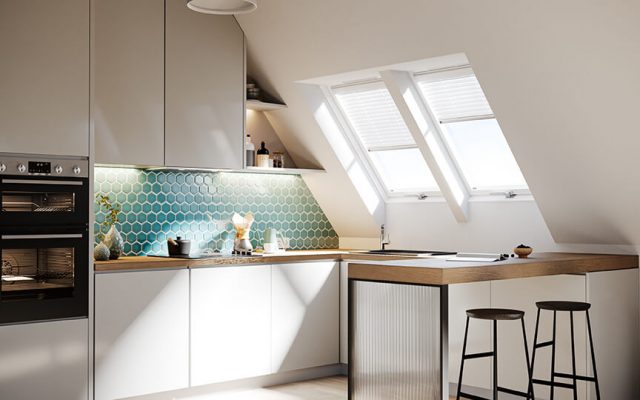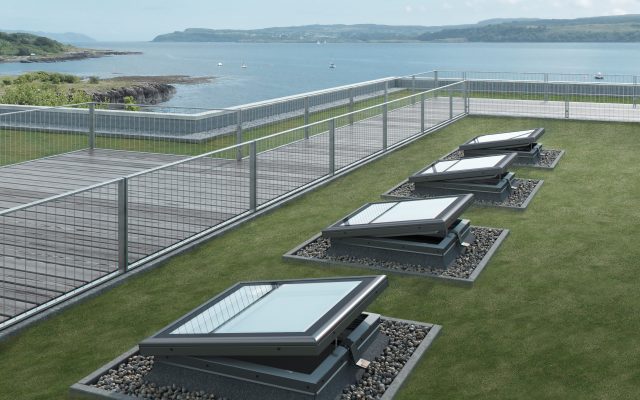A roof window can make a hugely positive difference to your home, from improving energy efficiency and mental health to being a great investment for the future. Yet, when it comes to installing one, understanding the right pitch for your roof window is essential.
What is pitch? How does it affect your roof window? In this guide, we will explore roof window pitch and how it can affect your new fixture, as well as how to find the right pitch for your needs.

What Is Roof Window Pitch?
Roof window pitch describes the angle of the roof window, stemming from the pitch of the roof. For reference, most architects would design a roof pitch of between 48 and 51 degrees. This is ideal for pitched roof windows such as those offered by DAKEA.
Why Does it Matter?
Roof pitch matters for your roof window because if one end of the roof window is not pitched up, water can pool on the window. If you have a ‘flat roof’ (note, these still have a slight pitch to prevent water from pooling on the roof), you will need to buy a specialized flat roof window.
This means that understanding the pitch of your roof window is crucial – it will help you buy the right roof window for your needs, rather than ending up with one that is not suitable, spoiling your enjoyment of your new roof window.
Finding the Right Pitch for a Roof Window
When you are shopping for a roof window, you will need to know the pitch of your roof. To measure the pitch of your roof from the inside, you can use an app on your smartphone. On iPhone, the measurement app has a level setting that you can use to learn your roof’s pitch. There are also numerous apps on Android that you can use in the same way.
There are also specialised roof pitch calculator apps that you can use to simplify the process. Please note that the roof pitch is different from the roof’s slope.

The Minimum Required Pitch
The minimum required pitch for a DAKEA roof window is five degrees. If you don’t have a pitch of five degrees, rainwater will not be able to drain off the roof window. While this is the minimum, a higher pitch for your roof window is ideal.
What to Do If You Don’t Have a Higher Roof Pitch
If your roof pitch is not high enough for a roof window to drain properly, don’t despair – there are other ways to increase your roof pitch without redesigning your home. The most common one is to use an upstand.
An upstand is a small stand for your roof window that projects beyond the roof’s standard surface and creates additional pitch for the roof window. In turn, this means that the waterproofing on your roof window will be able to tolerate the water levels, reducing the risk of leaks from your roof window.
Installing an upstand is an easy addition, but may require you to get planning permission for your roof window. If the upstand and roof window, combined, project more than 150mm from the roof’s plane, you will need to get planning permission before installing it.
The Correct Pitch for a Roof Window
We hope that this guide on understanding the correct pitch for a roof window has been helpful. While a pitch of between 15 and 90 degrees is ideal, below this a flat roof window is still an option. If you have an exceptionally flat roof, you will likely need to purchase and fit an upstand before adding the roof window, but this should not be an issue.
If you would like to learn more about the specific requirements surrounding roof window pitch or discuss purchasing a roof window, please contact our experts, and we will be happy to help you.
Roof Window Pitch FAQs
Can You Add a Skylight to a Flat Roof?
A fixed flat roof skylight can be installed on flat roofs. You will however need to account for water drainage, either by choosing a curved model or through the use of an upstand. We have both fixed and electric opening models available, including the Azure and Control models.
Why Is Five Degrees of Pitch Required?
Without at least three degrees of pitch, water will be able to pool on your roof window, a process known as ponding. This in turn can lead to unsightly marks on your roof window.
What Are the Planning Permission Requirements for a Roof Window?
If your roof window will protrude by more than 150mm, or if any of the skylight will be higher than your roof’s apex, you will need to get planning permission. To learn more, read our blog on planning permission for roof windows.


